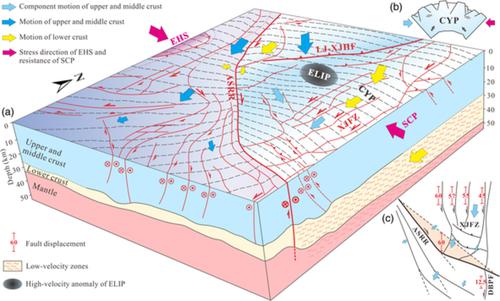当前位置:
X-MOL 学术
›
Geolog. J.
›
论文详情
Our official English website, www.x-mol.net, welcomes your
feedback! (Note: you will need to create a separate account there.)
Quantifying the contribution of upper-middle crustal shortening and lower crustal thickening to surface uplift in the south-eastern Tibetan Plateau
Geological Journal ( IF 1.4 ) Pub Date : 2021-03-02 , DOI: 10.1002/gj.4113 Chaoyang Li 1, 2 , Xiaodian Jiang 1, 3 , Wei Gong 1, 3
Geological Journal ( IF 1.4 ) Pub Date : 2021-03-02 , DOI: 10.1002/gj.4113 Chaoyang Li 1, 2 , Xiaodian Jiang 1, 3 , Wei Gong 1, 3
Affiliation

|
Surface uplift occurs as a result of tectonic uplift related to crustal deformation and isostatic compensation due to surface erosion. To determine and quantify the key controlling factors responsible for surface uplift in the south-eastern Tibetan Plateau, we calculated isostatic compensation using topographic data along five wide-angle seismic profiles across the Chuandian Block, Indochina Block, and South China Plate, and examined the correlations between tectonic uplift and each crustal layer thickness. The average isostatic compensation caused by surface erosion is 340–480 m, which is approximately 13–26% of the total surface uplift. The geodynamic implications in relation to the Global Positioning System, focal mechanisms (P axes), seismic anisotropy (Pms splitting), and low-velocity zones were also investigated. The low-velocity zones with long-distance southward extension seemed to be significantly reduced, and were divided into two branches by resistance from the inner zone of the Emeishan large igneous province (ELIP) when it is extending into the southern Chuandian Block. The lower crustal thickening related to low-velocity zones reconstructed a partial crustal structure of the ELIP, and contributed at least 53–62% of the total surface uplift at the western branch, and almost 46–65% at the eastern branch. With the limitations imposed by the rigidity of the South China Plate and Indochina Block, the south-eastern motion of the upper-middle crust was strongly decoupled with southward lower crustal flow, as revealed by the unmatched pattern between P axes and Pms splitting. The south-eastward motion of southern Chuandian Block resulted in upper-crustal folding in the W–E direction, upper-crustal thrusting in the N–S direction, and contributed approximately 9–28% of the total surface uplift in some locations. We emphasize the indispensability of upper-crustal shortening in the frontal zone of the south-eastern Tibetan Plateau and introduce the transitional characteristics of the southern Chuandian Block, from typical lower crustal flow to coupled crustal brittle shortening.
中文翻译:

量化青藏高原东南部中上地壳缩短和下地壳增厚对地表隆升的贡献
地表抬升是由于与地壳变形和地表侵蚀等静压补偿相关的构造抬升的结果。为了确定和量化青藏高原东南部地表隆升的关键控制因素,我们利用川甸地块、中南半岛地块和华南板块的五个广角地震剖面的地形数据计算了等静压补偿,并检查了青藏高原东南部地表隆升的关键控制因素。构造隆升与各地壳层厚度的相关性。由地表侵蚀引起的平均等静压补偿为 340-480 m,约占总地表隆起的 13-26%。还研究了与全球定位系统、震源机制(P 轴)、地震各向异性(Pms 分裂)和低速带相关的地球动力学影响。长距离向南延伸的低速带似乎明显减少,在延伸到川店地块南部时,被峨眉山大火成岩省(ELIP)内带的阻力分为两个分支。与低速带相关的下地壳增厚重建了 ELIP 的部分地壳结构,西支至少贡献了总地表隆升的 53-62%,东支几乎贡献了 46-65%。受华南板块和印度支那地块刚性的限制,中上地壳的东南运动与下地壳向南流动强烈脱钩,P轴和Pms分裂之间的不匹配模式揭示了这一点。川店地块南部的东南运动导致上地壳W-E向褶皱,N-S向上地壳逆冲,部分地区贡献了地表总隆升的9-28%。强调青藏高原东南部锋区上地壳缩短的必要性,介绍川店地块南部从典型的下地壳流向耦合地壳脆性缩短的过渡特征。
更新日期:2021-03-02
中文翻译:

量化青藏高原东南部中上地壳缩短和下地壳增厚对地表隆升的贡献
地表抬升是由于与地壳变形和地表侵蚀等静压补偿相关的构造抬升的结果。为了确定和量化青藏高原东南部地表隆升的关键控制因素,我们利用川甸地块、中南半岛地块和华南板块的五个广角地震剖面的地形数据计算了等静压补偿,并检查了青藏高原东南部地表隆升的关键控制因素。构造隆升与各地壳层厚度的相关性。由地表侵蚀引起的平均等静压补偿为 340-480 m,约占总地表隆起的 13-26%。还研究了与全球定位系统、震源机制(P 轴)、地震各向异性(Pms 分裂)和低速带相关的地球动力学影响。长距离向南延伸的低速带似乎明显减少,在延伸到川店地块南部时,被峨眉山大火成岩省(ELIP)内带的阻力分为两个分支。与低速带相关的下地壳增厚重建了 ELIP 的部分地壳结构,西支至少贡献了总地表隆升的 53-62%,东支几乎贡献了 46-65%。受华南板块和印度支那地块刚性的限制,中上地壳的东南运动与下地壳向南流动强烈脱钩,P轴和Pms分裂之间的不匹配模式揭示了这一点。川店地块南部的东南运动导致上地壳W-E向褶皱,N-S向上地壳逆冲,部分地区贡献了地表总隆升的9-28%。强调青藏高原东南部锋区上地壳缩短的必要性,介绍川店地块南部从典型的下地壳流向耦合地壳脆性缩短的过渡特征。











































 京公网安备 11010802027423号
京公网安备 11010802027423号